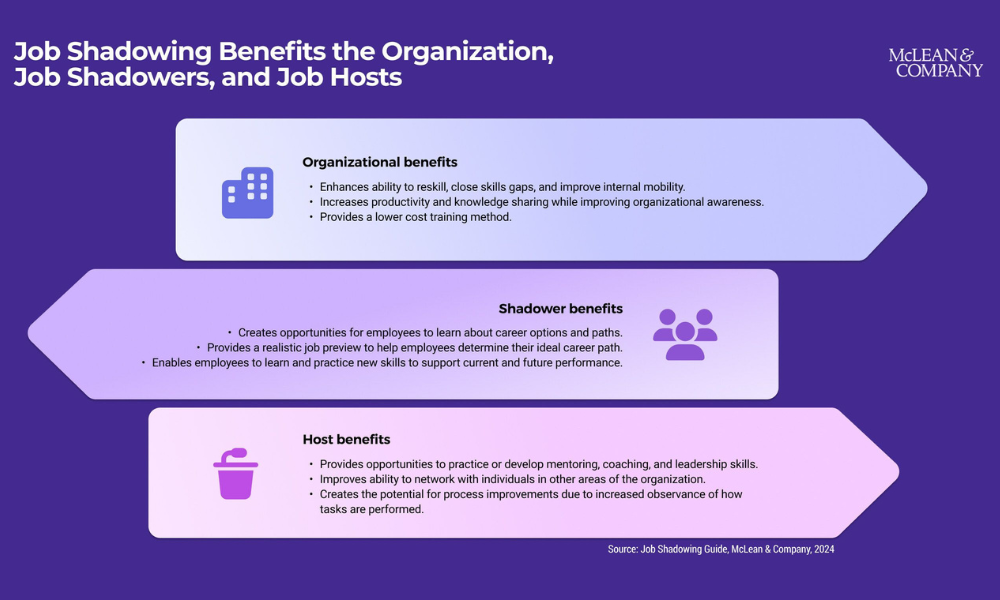New guide explains how shadowing can help professional development and employee retention

As organizations continue to face labour shortages and struggle with talent retention, global HR research and advisory firm McLean & Company says job shadowing is another tool employers can use to support career development, knowledge and skill building, and onboarding of new hires. Job shadowing is a benefit that can create the perception of career opportunities within the organization as well as demonstrate that the employer cares about its employees.
In a new industry resource, the Job Shadowing Guide, McLean & Company offers tips and advice about job shadowing. The guide defines job shadowing as what happens when employees observe experienced individuals, also called job hosts, as they perform their duties for a short period of time. Occasionally, the observing employee, also called the job shadower, may practice performing tasks. To achieve mutual benefits, such as improved employee engagement and productivity, a job shadowing program must address and provide value to the organization's unique needs while also delivering value to the job shadowers and job hosts.
Laura Ribadeneira, director HR advisory services with McLean & Company, says, “Job shadowing supports employees looking for career advancement, which is the number one reason employees leave an organization, and supports employee engagement as well.
“Job shadowing can emphasize those opportunities that the organization wants to highlight, particularly where they seek to increase internal mobility, internal movement, and interest among their existing employees.”

When job shadowing programs are implemented correctly, there are additional benefits such as increased productivity, skill development enablement, and organizational awareness. However, achieving mutual benefits requires that the program be designed to facilitate learning and engage the right participants. As observation doesn't always lead to knowledge or skill transfer, hosts must be carefully selected to ensure they are competent in their roles and have a desire to build mentoring, coaching, and leadership skills.
The guide says there can also be challenges associated with job shadowing. For example, negative habits may be passed from the host to the shadower and temporary reductions in productivity may occur as participants must balance their primary roles with the needs of the job shadowing program. Ribadeneira says it is important that the host is engaged and interested in the program and is at least a moderate- to high-performing employee that is competent and has the skills and habits the organization wants emulated.
Create purpose and goals
“Our process encourages organizations to identify the reason they want to utilize job shadowing and how they can create some purpose and goals around it,” she says. “They can look at typical needs they might use to orient the programs. One can be career development to provide employees with an opportunity to explore different career opportunities. Another instance would be knowledge and skills building for employees that need to understand the organization more broadly or need to develop a particular skill set. The basic and introductory use of job shadowing would be in onboarding; giving new hires exposure to the organization to understand how it works and how their role fits in with other roles. The program can be anything from an informal event to something quite structured.”
To assist HR leaders in understanding, planning for, and implementing the right job shadowing program for their organizations, the guide outlines 10 steps, which include determining the goals and approach, selecting participants, and collecting feedback for continuous improvement. A dedicated full-page breakdown for each step is included in the complete resource.
“Think of it like a learning opportunity,” says Ribadeneira. “It's important to reinforce the learning after the experience. I would suggest for employees that have had a job shadow experience, that their manager reflects on it with them afterwards.”
McLean & Company advises HR leaders that ongoing coordination is required to maintain a formal program and that investing in employee learning and development through job shadowing can yield long-term dividends for all key players.
The Job Shadowing Guide is a component of the broader Implement a Job Rotation Program research and part of a series of HR tools offered by McLean & Company.



